Article by Angela Connor; Wednesday, Mar. 20, 2013
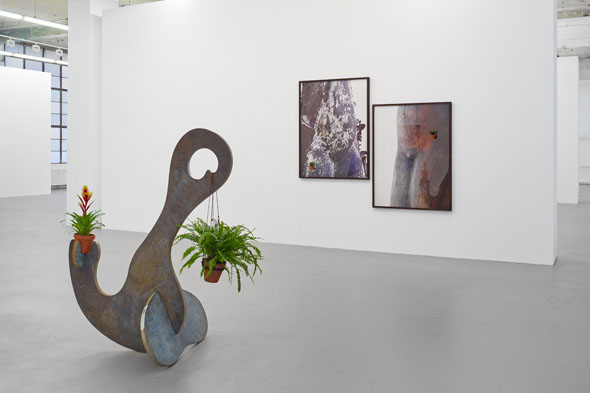 Ernesto Neto, notes, stones and dots, installation view; courtesy of Galerie Max Hetzler
Ernesto Neto, notes, stones and dots, installation view; courtesy of Galerie Max Hetzler
Ernesto Neto’s stature as one of Brazil’s leading contemporary artists has been cemented in the last ten years with his immersive sculptures at the Venice Biennale (2001), Panthéon, Paris (2006) and Hayward Gallery, London (2010). With a playful oeuvre of phallic forms, abstract shapes and womb-like structures, Neto has earned his reputation as a hedonistic artist who encourages the spectator to take pleasure in life, lust and nature.
Neto’s latest exhibition ‘notes, stones and dots’ at Max Hetzler gallery takes a less immersive direction than his more well-known works and is a two pronged fork: a collection of free-spirited sculptural objects assembled from steel and a series of close-up photographs of genitalia from well-known sculptures from the Nasher Sculpture Center, Texas, United States.
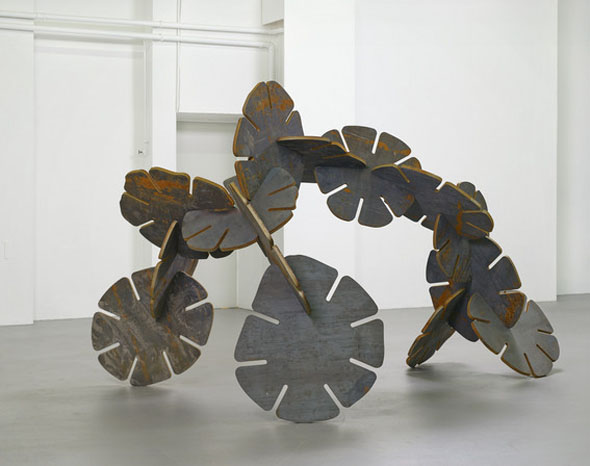 Ernesto Neto – “Animal Nature” (2013), 25 mm corten steel, 216 x 348 x 216 cm; courtesy of Galerie Max Hetzler
Ernesto Neto – “Animal Nature” (2013), 25 mm corten steel, 216 x 348 x 216 cm; courtesy of Galerie Max Hetzler
Resembling oversized objects for toddlers, Neto’s machine-cut sculptures animate the collaboration between nature and technology: simultaneously whimsical and austere, feminine and masculine, flirtatious and frigid. With a cookie-cutter aesthetic, his works are fabricated in the shape of foliage, flowers and abstract shapes, which are then slotted together to form freestanding sculptures.
Despite the weighty medium, his life-sized sculptures appear deceptively buoyant, as if they could be cavorting or frolicking amongst party makers at Carnival in Rio de Janeiro. In animal nature, the organic palette mixed with the cloning of the same component incites images of cells regenerating. Similarly in the corner of life, Neto conjures up images of breasts, buttocks and bones. This ambiguity of form incites the imagination of the viewer and harnesses multiple readings of the work, leaving each sculpture charged with intrigue.
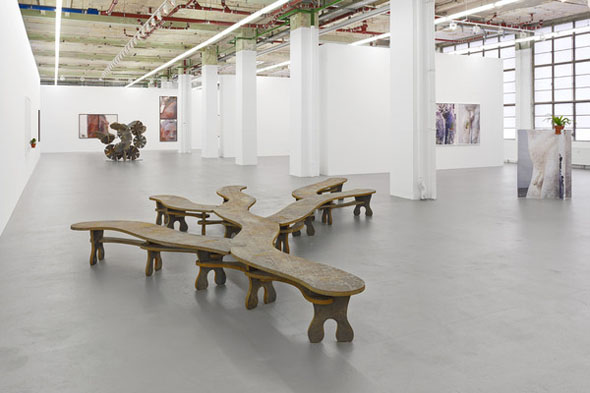 Ernesto Neto, notes, stones and dots, installation view; courtesy of Galerie Max Hetzler
Ernesto Neto, notes, stones and dots, installation view; courtesy of Galerie Max Hetzler
Over time the steel will oxidize, turning a reddish brown colour, reminiscent of the changing of seasons, vegetation and the natural world. The opposition between the materiality of the sculptures and the infant inspired subject matter creates a further tension in the work. Contrasts between organic and technological become apparent, drawing comment on the increase of urbanization and our concrete landscape.
At the intersection between contemporary design and art, Neto brings the utilitarian to his sculptural works. His works in the corner of life and a tree on the way are multi-functional in that they can also be used to hang plants, sit on or lie in – which Neto was coaxing people to do at the exhibition opening. It is clear that Neto is a passionate man as he bounded around the space inviting social interaction with his works.
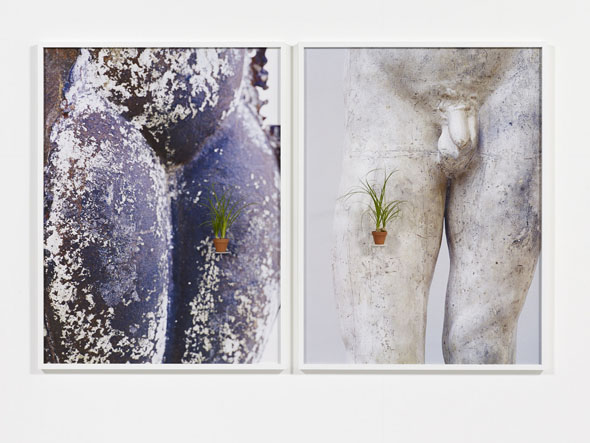 Ernesto Neto – “btw us” (2013), 2 photographs, 2 ceramic pots with plants (Kalanchoe tomentosa and Aloe variegata), diptych: 146 x 110 cm each; courtesy of Galerie Max Hetzler
Ernesto Neto – “btw us” (2013), 2 photographs, 2 ceramic pots with plants (Kalanchoe tomentosa and Aloe variegata), diptych: 146 x 110 cm each; courtesy of Galerie Max Hetzler
During a visit to Texas, Neto photographed close-up images of intimate body parts from well-known sculptures including the wooden Tahitian Girl by Gauguin, The Kiss by Brancusi and the bronze Animal Woman by Beuys. Although the large-scale images are of male and female genitalia, the sexuality of the figures is desensitized through the cold and hard materiality of the original sculptures. Tiny plants rest on shelves on the photographs forming a thread between his sculptures and photographs. The curve of the breasts and buttocks of the photographs mimic the lines in the sculptures, exploring the interconnectivity of the natural world, culture and human existence.
Ernesto Neto’s works draw no distinction between art and living. His youthful personality is evident through his works and he produces a persuasive engagement between the environment and our selves. Previously compared by many to a playground, his works are an assertion of life and offer a temporary escape from the banality and harshness of contemporary life.
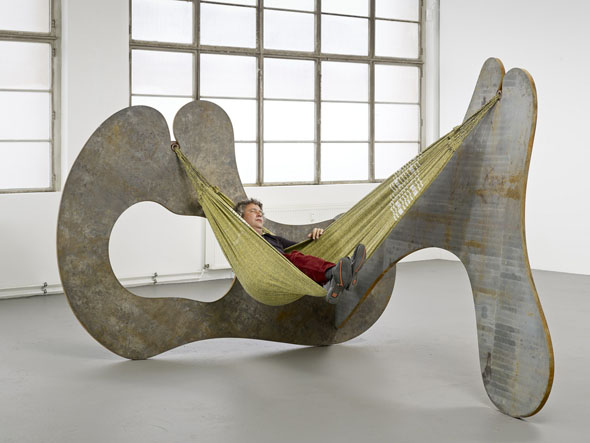 Ernesto Neto – “In the Corner of Life” (2013), 30 mm corten steel and hammock, 330 x 220 x 191 cm; courtesy of Galerie Max Hetzler
Ernesto Neto – “In the Corner of Life” (2013), 30 mm corten steel and hammock, 330 x 220 x 191 cm; courtesy of Galerie Max Hetzler
______________________________________________________________________
Additional Information
GALERIE MAX HETZLER
“Notes, Stones and Dots” – ERNESTO NETO
Exhibition: Feb. 23 – April. 13, 2013
Oudenarder Straße 16-20 (click here for map)
___________________________________________________________________________________
Angela Connor is an Australian writer, photographer and curator currently based in Berlin. She has worked in both commercial and independent art spaces, as well as teaching at the Victorian College of the Arts, Melbourne, Australia, as part of the KPMG Tutorship Award. In 2008 she received her Masters of Fine Arts by Research examining the portrayal of blindness in 20th Century photography.




















